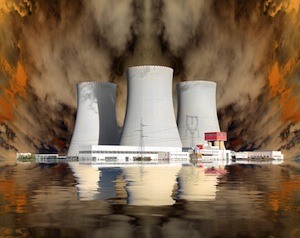8 Shocking Health Effects from the Fukushima Disaster |  |
| 8 Shocking Health Effects from the Fukushima Disaster Posted: 06 Jun 2014 08:00 AM PDT  It’s been a couple years since the Fukushima disaster but the ruins are still smoldering and the negative health consequences are more pronounced than ever. The somewhat indifferent response from many governmental health agencies around the world to the Fukushima disaster was perhaps more shocking than the disaster itself. Authorities around the globe assured us not to worry, claiming any radiation that had come into contact with citizens was well below the detectable and harmful level. The message is clear, everyday citizens can longer rely on their government for protection.
As tons of radioactive water continues to spill into the Pacific Ocean, many national health agencies have raised the standards for acceptable radiation exposure to reinforce their absurd statements. The previous standards for 30 years of radiation exposure would have generated a cancer rate of 1 in 10,000. Now that radiation standards have been raised (thanks to the Obama Administration's green-lit effort to increase radiation exposure to 2,000 millirems), the cancer rate from 30 years of exposure is now at 1 in 23! [1] What other problems have sprung up since the nuclear disaster in Fukushima? 1. Skin ContaminationSkin contamination remains one of the greatest risks following a radiological disaster like Fukushima. The availability of radiological decontamination agents remained in limited supply immediately following the disaster, and many of these agents require fresh water. Unfortunately, access to clean water can be very difficult in areas near Fukushima due to the high levels of radiation. [2] Skin exposure to chemicals and radiation may result in superficial skin issues and endocrine damage. [3] 2. Psychological TraumaData indicates that workers and mothers of young children have the greatest risk of PTSD, depression, and anxiety following a radiological event. These effects may be a direct result from exposure to radiation, and radiation itself may be directly linked to mood disorders. Also, parents may fear for their family's well being during and after a nuclear disaster, further increasing the chances of becoming psychologically and emotionally unstable. [4] Children and adolescents may also experience long-term psychological difficulties with unknown consequences. [5] 3. CancerScientists and governmental health agencies have been highly aware of radiation’s impact on cancer risk in humans and animals. High doses can be fatal and increase the chances of inheritable genetic defects. [6] 4. Thyroid DamageIodine 131, a radioisotope of iodine found in nuclear fission, quickly accumulates in the thyroid and replaces stable, beneficial iodine. It disrupts normal thyroid function to negatively impact hormones, body weight, and energy levels. This iodine isotope can cause thyroid cancer and hypothyroidism. [7] Nuclear disasters, specifically those in Chernobyl, Hiroshima, and Fukushima, have resulted in a significant increase in thyroid cancers. [8] 5. Women are More at RiskResearch conducted in the area around Fukushima explored the impact radiation had on men and women and how the genders compared when it came to health risk severity. Women proved more sensitive to the effects of radiation, with pregnant women displaying an even higher level of susceptibility. [9] 6. Pregnancy IssuesPregnant women are at a higher risk for developing issues related to iodine deficiency when exposed to iodine 131, an issue that can slow thyroid and hormone function. Iodine deficiency in pregnant women can cause miscarriage, stillbirths, and other complications. [10] As the years continue to pass following the Fukushima disaster, Japanese officials still claim ignorance of the possible effects radiation has on pregnant women and their unborn children. 7. Thyroid Disorders and NewbornsDespite the multitude of health effects to the developing fetus, research has uncovered severe issues with radiation on the thyroid gland in newborn infants. From March to June of 2011, thyroid problems soared 28% in babies born along the Pacific Rim. States along this area include Hawaii, California, Oregon, Washington, and Alaska. A 2013 study published in Open Journal of Pediatrics noted significantly higher incidences of hypothyroidism in these states. [11] 8. Thyroid Cancer in ChildrenDuring a radiological event, protecting the health of children (the most susceptible population group) becomes a foremost issue. [12] To date, 44 Japanese children under the age of 18 living near Fukushima's nuclear plant at the time of the disaster have developed thyroid cancer, a significant increase compared to cancer incidences prior to the event. What Can Be Done During a Nuclear Event?Any type of nuclear emergency requires immediate action in an effort to protect citizens. Government authorities will typically administer high doses of potassium iodide to those affected in an effort to block thyroid absorption of iodine 131. [13] While this traditional protocol may help, the results show the need for better, more effective protective options. When it comes to protecting yourself and your family, you ultimately have to rely on your own efforts rather than those exercised from official members of the government. Although potassium iodide has been traditionally used to block the absorption of iodine 131 in the thyroid, it is not the most efficient form of iodine for the human body. Nascent iodine offers a more bioavailable option with a higher rate of absorption. Detoxification may also be helpful for removing impurities and toxic metals that may accumulate during a nuclear event. What are your favorite ways to protect yourself from overseas radiation? Let us know in the comments! -Dr. Edward F. Group III, DC, ND, DACBN, DCBCN, DABFM References:
The post 8 Shocking Health Effects from the Fukushima Disaster appeared first on Natural Health & Organic Living Blog. |
| You are subscribed to email updates from Natural Health & Organic Living Blog To stop receiving these emails, you may unsubscribe now. | Email delivery powered by Google |
| Google Inc., 20 West Kinzie, Chicago IL USA 60610 | |
No comments:
Post a Comment